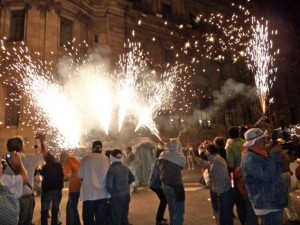
As the summertime approaches, the Spanish find reason to celebrate. Mark these festive dates for the best bashes on the Iberian Peninsula:
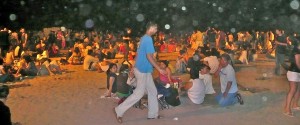
June – Welcome Summer in Mediterranean Spain
June 21, or thereabouts, is generally considered to be the summer solstice in the western world. In Spain, the official spring-to-summer jump is the 23rd of June on Sant Joan’s Day (San Juan in Spanish). The change of the season is celebrated with wild all-night shindigs along the Mediterranean. In Barcelona, locals head to the beach for a night of bonfires, sandy barbecues and an arsenal of firecrackers. To do it like the locals, bring your picnic dinner, a cooler with chilled cava, a blanket and an urge to see the sun rise over the Med.
If you’d rather not lay about in the sand and prefer to be out of the line of fire (there seem to be no rules as to where teens should light and aim their firecrackers and it can get hairy on the beach) then book a table at the W Hotel, which has some of the top views of Barcelona’s seashore.
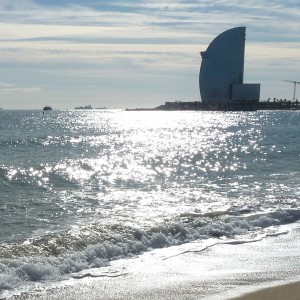
Apart from Barcelona, the Mediterranean Island of Minorca also has its own peculiar Sant Joan celebration. Held in Minorca’s main city, Ciutadella, the Festes de Ciutadella begin on the June 23 and the main attraction is the coal-black Minorcan horses, a registered breed from the island. People gather to admire these graceful Minorcan horses as they dance on their hind legs through the streets of Ciutadella. Riders or Caixers hold on tight to their flashy steads while parade-goers attempt to pat the horses’ chests, an act which brings good luck. This horse festival begins on the 23rd and this one is the most popular (and crowded). However, the festival continues to be held all over the island the rest of the summer, meaning if you don’t make it to Ciutadella on the 23rd and 24th, you’ll have another chance to see the dancing horses in a smaller Minorcan village.
See more on how to horse around with the pros here: www.santjoanweb.com
July – Beckoning the Beast
The Running of the Bulls, or San Fermin in Spanish, may be Spain’s most well-known festival with North Americans: People know about this week-long blowout thanks to Hemingway’s The Sun Also Rises. Indeed, the sun does rise over Pamplona from July 6-14 and shortly thereafter the Running of the Bulls begins (at 8 a.m.). The beasts dash through the streets and the brave/stupid/adventurous/(insert your adjective here) runners take off in front of the bulls, trying to avoid getting trampled, gored, or both.
Gore. This is a good verb to keep in mind when considering San Fermin. It’s important to realize that many of the bulls that run are then killed by a bullfighter. It’s also important to know that many people are injured and even killed each year at San Fermin. For the most part, runners are screened beforehand. That means no drunks (there are a lot of those at this party!) and no one in sandals. You have to be prepared. There is a detailed description of the run here.
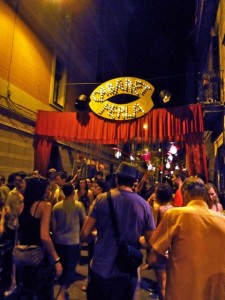
If you’re thinking, “This is definitely not my thing,” then hold on! There is more to San Fermin than bulls, running, fighting and testosterone. Many Spaniards I’ve met over the years have told me that they believe San Fermin is the best festival in Spain, and many of these locals were not Basque and do not like bullfighting. Most come for the food, drinking, dancing and atmosphere, not for the bulls (in fact, since the bulls run so early in the morning, lots of San Ferminers are asleep or headed toward bed when the animals being their journey through town).
If you’re interested in running with the bulls or just want to party, then check out Girls Running With Bulls (a site run by five women who plan to run in 2012 — runners are usually men) and the Pamplona website, which has lots of tips on planning your experience.
August – A Block Party of Epic Proportions
In August, the whole of Spain goes on vacation. The streets are empty in Barcelona. It’s easy to park. Many restaurants and shops in non-touristy areas are closed for the month. In fact, August can be a bit boring in Barcelona except for one week when the Festa Major de Gràcia is held. From the 15th to the 21st the fiesta or festa (in Catalan) does not stop in this super-hip part of the metropolis. There’s live music every night at multiple stages, activities and entertainment for the kids in the mornings, and best of all the streets of Gràcia are elaborately decorated for the celebration. In fact, the decorations are a contest and each year one street wins. Expect to be impressed and expect it to be crowded. This festival is free, which means everyone who is in town in August makes an appearance in Gràcia.
See more on the lineup for the Festa Major de Gràcia 2012 here: www.festamajordegracia.cat
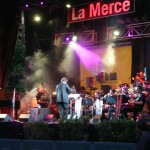
September- Celebrating Barcelona’s Patron Saint
It’s hard to beat the Gràcia parties, but La Mercè manages to do so. If Sant Joan in June kicks off the summer, then La Mercè closes it out from the 21st to the 24th of September. La Mercè is the city’s patron saint and it’s only the best for her! The whole of Barcelona embraces La Mercè with live music in all the main plazas and amphitheaters, fireworks, devilish fire-runs called correfocs, family entertainment, castellers (human castles), folk dancing and parades featuring giant puppets and dragons. It’s endless and a little overwhelming and it’s all free.
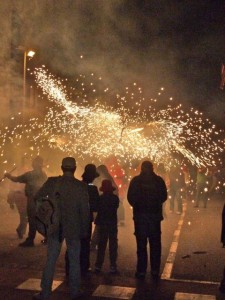
Some big names in music are usually brought in for La Mercè (though this may be less true now, with the economic crisis and all) and it pays to get a La Mercè schedule in advance and plan what you want to experience. Another tip: if you plan to stay in the center of the city, note that it will be noisy with La Mercè jubilation and it may be hard to sleep. Better to book away from the Gothic Quarter and Pl. Catalunya for these dates.
For more on La Mercè check the city webpage as the date approaches: www.bcn.cat


